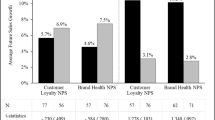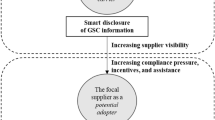Abstract
The implicit promise of a partnership in a loyalty program (LP) is that the partners will gain new customers and the LP will reinforce the loyalty to focal partners. Although customers may be encouraged to cross-purchase from partners (which may create positive synergies), they can also switch among partners without forfeiting rewards (which may lead to the cannibalization of sales among partners). To explore these cross-partner effects, we analyze the evolution of customer purchases in a partnership LP across 33 partners from 16 industry sectors. We find that cannibalizations arise more frequently than synergies among partners, contributing to a “rich-get-richer” effect for high-penetration partners; e.g., 10% increase in transactions at department stores reduce transactions at apparel partners (by .04% for new transactions and by 1.18% for recurring customers); but in turn, they attract positive synergies from apparel (.11% increase in transactions by new customers and .37% for recurring transactions).



Similar content being viewed by others
Notes
We only observe transactions in the partnership LP that are linked to the partnership LP card. Customers might have used other types of payments (e.g., cash) that would not be included in this data set. However, since this is in essence a payment card because it is a credit-card-based LP, customers likely use the card regularly as a general means of payment. Moreover, if the same effect occurs repeatedly across each subsequent cohort that joins the LP, we have reason to believe that the effect is not sporadic.
Semi-elasticity is preferred over standard elasticity for these variables because, for the ZIP model, it gives a simple expression that is easy to interpret. Semi-elasticity only depends on the parameters and the probability of excess zeros. (Standard) elasticity would also depend on the level of the explanatory variable. A downside of semi-elasticity is that it depends on the scale at which the x-variable is measured.
These three variables will be highly correlated, but this is not a problem for the estimation because we are predominantly interested in controlling for any time trend that may be present rather than in accurately attributing the time trend to the linear, quadratic, and log parts.
References
Berman, B. (2006). Developing an effective customer loyalty program. California Management Review, 49(1), 123–148.
Bolton, R. N., Kannan, P. K., & Bramlett, M. D. (2000). Implications of loyalty program membership and service experiences for customer retention and value. Journal of the Academy of Marketing Science, 28(1), 95–108.
Bombaij, N., & Dekimpe, M. (2020). When do loyalty programs work? The moderating role of design, retailer-strategy, and country characteristics. International Journal of Research in Marketing, 37(1), 175–195.
Breugelmans, E., Bijmolt, T. H. A., Zhang, J., Basso, L. J., Dorotic, M., Kopalle, P., Minnema, A., Mijnlieff, W. J., & Wünderlich, N. V. (2015). Advancing research on loyalty programs: a future research agenda. Marketing Letters, 26, 127–139.
Capizzi, M. T., & Ferguson, R. (2005). Loyalty trends for the twenty-first century. Journal of Consumer Marketing, 22(2), 72–80.
Chaudhuri, M., Voorhees, C. M., & Beck, J. M. (2019). The effects of loyalty program introduction and design on short-and long-term sales and gross profits. Journal of the Academy of Marketing Science, 47(4), 640–658.
Chung, J., & Rao, V. R. (2003). A general choice model for bundles with multiple-category products: application to market segmentation and optimal pricing for bundles. Journal of Marketing Research, 40(2), 115–130.
Colloquy (2017). 2017 Colloquy Loyalty Census, LoyaltyOne, Retrieved on May 20, 2018 from https://www.colloquy.com/reports/
De Noni, I., Orsi, L., & Zanderighi, L. (2014). Coalition loyalty-programme adoption and urban commercial-network effectiveness evaluation. International Journal of Retail & Distribution Management, 42(9), 818–838.
Dorotic, M., Fok, D., Verhoef, P. C., & Bijmolt, T.H.A. (2011). Do vendors benefit from promotions in a multi-vendor loyalty program? Marketing Letters, 22(4), 341–356.
Dorotic, M., Bijmolt, T. H. A., & Verhoef, P. C. (2012). Loyalty programmes: cu rrent knowledge and research directions. International Journal of Management Reviews, 14(3), 217–237.
Dorotic, M., Verhoef, P. C., Fok, D., & Bijmolt, T. H. A. (2014). Reward redemption effects in a loyalty program when customers choose how much and when to redeem. International Journal of Research in Marketing, 31(4), 339–355.
Dowling, G. R., & Uncles, M. (1997). Do customer loyalty programs really work? Sloan Management Review, 38(4), 71.
Drèze, X., & Nunes, J. C. (2011). Recurring goals and learning: The impact of successful reward attainment on purchase behavior. Journal of Marketing Research, 48(2):268–281.
Dwyer, F. R., Schurr, P. H., & Oh, S. (1987). Developing buyer–seller relationships. Journal of Marketing, 51(2), 11–27.
Evanschitzky, H., Ramaseshan, B., Woisetschläger, D. M., Richelsen, V., Blut, M., & Backhaus, C. (2012). Consequences of customer loyalty to the loyalty program and to the company. Journal of the Academy of Marketing Science, 40(5), 625–638.
Finaccord (2015). Global Coalition Loyalty Programs, Retrieved on September 20, 207 from http://www.finaccord.com/documents/report_prospectus_global_coalition_loyalty_programs.pdf
Geyskens, I., Gielens, K., & Wuyts, S. (2015). United we stand: the impact of buying groups on retailer productivity. Journal of Marketing, 79(4), 16–33.
Heilman, C. M., Bowman, D., & Wright, G. P. (2000). The evolution of brand preferences and choice behaviors of consumers new to a market. Journal of Marketing Research, 37(2), 139–155.
Kim, S. J., Wang, R. J. H., & Malthouse, E. C. (2015). The effects of adopting and using a brand’s mobile application on customers' subsequent purchase behavior. Journal of Interactive Marketing, 31, 28–41.
Kivetz, R., Urminsky, O., & Zheng, Y. (2006). The goal-gradient hypothesis resurrected purchase acceleration, illusionary goal progress, and customer retention. Journal of Marketing Research, 43, 39–58.
Lara, P. R., & De Madariaga, J. G. (2007). The importance of rewards in the management of multisponsor loyalty programmes. Journal of Database Marketing & Customer Strategy Management, 15(1), 37–48.
Lederman, M. (2008). Are frequent-flyer programs a cause of the “hub premium”? Journal of Economics & Management Strategy, 17(1), 35–66.
Leenheer, J., Van Heerde, H. J., Bijmolt, T. H. A., & Smidts, A. (2007). Do loyalty programs really enhance behavioral loyalty? An empirical analysis accounting for self-selecting members. International Journal of Research in Marketing, 24(1), 31–47.
Lemon, K. N., & Wangenheim, F. V. (2009). The reinforcing effects of loyalty program partnerships and core service usage: a longitudinal analysis. Journal of Service Research, 11(4), 357–370.
Liu, Y. (2007). The long-term impact of loyalty programs on consumer purchase behavior and loyalty. Journal of Marketing, 71(4), 19–35.
Moore, G., & Sekhon, H. (2005). Multi-brand loyalty cards: a good idea. Journal of Marketing Management, 21((5–6)), 625–640.
Nachis, J. (2018). Coleman insights: why the Plenti loyalty program failed. Retrieved January 10, 2020 from https://colemaninsights.com/coleman-insights-blog/why-the-plenti-loyalty-program-failed
Orbis Research (2019). Loyalty management: Market growth trends and forecasts (2019-2024). Retrieved on January 27, 2020 from https://www.orbisresearch.com/reports/index/loyalty-management-market-growth-trends-and-forecasts-2019-2024
Roehm, M. L., Pullins, E. B., & Roehm Jr., H. A. (2002). Designing loyalty-building programs for packaged goods brands. Journal of Marketing Research, 39, 202–213.
Schumann, J. H., Wünderlich, N. V., & Evanschitzky, H. (2014). Spillover effects of service failures in coalition loyalty programs: the buffering effect of special treatment benefits. Journal of Retailing, 90(1), 111–118.
Sharp, B., & Sharp, A. (1997). Loyalty programs and their impact on repeat-purchase loyalty patterns. International Journal of Research in Marketing, 14(5), 473–486.
Shoulberg, W. (2018). Forbes: Plenti customer loyalty program to end in July: What went wrong?. Retrieved on Feb 15 2020 from https://www.forbes.com/sites/warrenshoulberg/2018/05/01/no-good-and-plenti-as-the-customer-loyalty-program-winds-down/#7047f5eb156d
The Loyalty Box (2017). Hidden dangers of coalition loyalty programs. Retrieved February 8, 2017 from http://www.theloyaltybox.com/blog/general-retail/hidden-dangers-coalition-loyalty-programs/
Villacé-Molinero, T., Reinares-Lara, P., & Reinares-Lara, E. (2016). Multi-vendor loyalty programs: influencing customer behavioral loyalty? Frontiers in Psychology, 7, 204.
Wang, R. J. H., Krishnamurthi, L., & Malthouse, E. C. (2018). When reward convenience meets a mobile app: Increasing customer participation in a coalition loyalty program. Journal of the Association for Consumer Research, 3(3), 314–329.
Acknowledgments
The authors would like to thank the corporate sponsor for making the data available and Wharton Customer Analytics at University of Pennsylvania for the research opportunity given to us as data awardees. Academic researchers are granted full authority to publish the results of their research. The authors also are grateful to participants of a special session on loyalty programs at EMAC 2016, Challenges of Europe 2019, and seminar participants at BI Norwegian Business School for their valuable suggestions.
Author information
Authors and Affiliations
Corresponding author
Additional information
Publisher’s note
Springer Nature remains neutral with regard to jurisdictional claims in published maps and institutional affiliations.
Marnik DeKimpe served as Area Editor for this article.
Supplementary Information
ESM 1
(DOCX 1218 kb)
Rights and permissions
About this article
Cite this article
Dorotic, M., Fok, D., Verhoef, P.C. et al. Synergistic and cannibalization effects in a partnership loyalty program. J. of the Acad. Mark. Sci. 49, 1021–1042 (2021). https://doi.org/10.1007/s11747-020-00759-7
Published:
Issue Date:
DOI: https://doi.org/10.1007/s11747-020-00759-7




